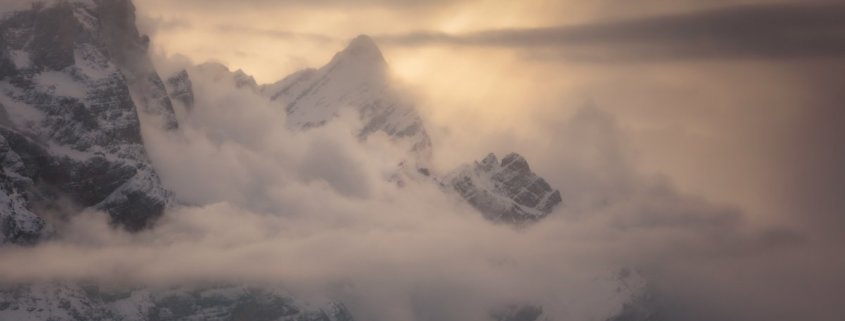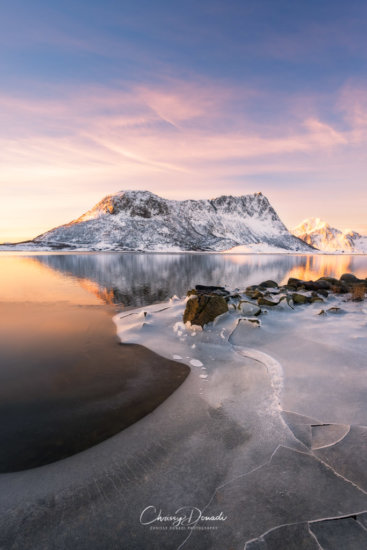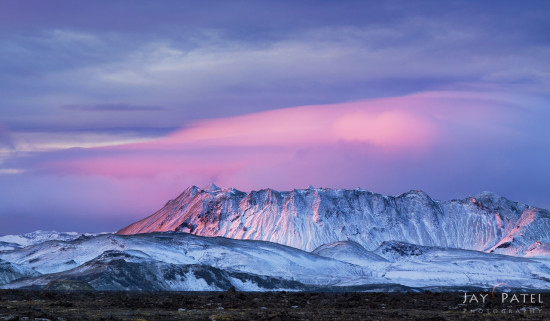5 Indispensable Winter Photography Tips and Tricks
Landscape photography in winter is one of my favorite times to shoot. The joy of hearing the snow crunch beneath your feet as you find the pristine location blanketed in white is magical. As you stand motionless, you can feel the quiet stillness from that blanket of snow covering the land. For me, these moments release all stress and breaths life back into my soul. That’s right, I really embrace winter photography.
Winter photography means later sunrises which allows the photographer to sleep in a little longer. Similarly, earlier sunsets enable dinner discussions about that evening’s sunset with enough time before bed to review images while warming up by the fire and sipping some hot chocolate. However, However, cold weather poses challenges to both photographers and their equipment. Follow these indispensable winter photography tips to ensure your gear stays safe, your fingers stay warm, and your images turn out stunning.
Protect Your Camera Gear in Freezing Temperatures
My unspoken rule is that if I’m wearing multiple layers, then my DSLR or mirrorless camera deserves at least 1 layer. While most digital cameras provide some weather protection, I don’t advise testing them to their limits. The longer your DSLR or mirrorless camera sits out naked in the cold, the probably increases that you will run into an issue based on the temperature, wind, snow, and/or ice.
To protect your equipment:
- Use a weatherproof camera bag: Keep your gear safe from snow, rain, and condensation. If I will be waiting for a long time, then I’ll take the digital camera off the tripod. Instead, I’ll put it in my camera bag or keep it close to my body. Sometimes, I’ll put it under my outer most layer. My goal is to not let the camera’s temperature drop too low unnecessarily by sitting out in the cold for long periods of time.
- Invest in a camera rain cover: Prevent moisture from snowflakes or drizzle from damaging your camera body and lens. For example, snowflakes can melt and then refreeze in little cracks or around your photography filters. A frozen photography filter to your camera lens in the field is frustrating! When the digital camera will be sitting on the tripod, I prefer to keep either a rain cover or wrap a scarf or balaclava around it. When possible, I use a lens hood as well. In reality, I’ll use whatever is available to protect it from the elements, particularly it there is any type of snow falling or blowing around. To be clear, when I’m actively shooting in clear conditions, my digital camera is naked. If I’m waiting for short periods of time in between shots, then I cover it.
- Store gear in a cold environment before heading outside: This helps avoid rapid temperature changes, which can cause condensation inside your lens.
These precautions will help you avoid costly repairs and extend the life of your gear during your winter adventures.
Wear Gloves for Winter Landscape Photography
Your hands are crucial when handling delicate camera controls in freezing weather. Apart from layered winter clothing, I bring at least 2 pair of good gloves. The first pair are my good, insulated, and provide good dexterity so I can shoot without my fingers being exposed to conditions. The second pair is simply a back-up if something happens to my first pair or if they get wet.
- Choose photography gloves with touch-sensitive tips: These allow you to operate your camera without exposing your fingers to the cold.
- Layer up: Use a thin glove liner beneath thicker gloves for added warmth and dexterity.
- Consider hand warmers: I always make use for chemical heat packs also known as hand warmers. I’ll keep them in my pockets to keep my hands warm. Sometimes, I’ll tape them to parts of my tripod which may be subjected to freezing or even throw one or two in my camera bag while outside so the inside of my camera bag doesn’t get too cold while outside. They don’t get too hot so there is no need to worry.
Proper hand protection ensures you can focus on composing your shots rather than warming your fingers.
Maintain Battery Life in Freezing Temperatures
While this may be the simplest piece of advice, I feel it is the most critical. One of the biggest challenges in winter photography is keeping your batteries from draining too quickly. Freezing temperatures can cause battery performance to plummet.
- Carry spare batteries in a warm pocket: Store them close to your body to maintain their charge. I keep my batteries in a case or bag and normally keep the bag in one of my interior coat pockets.
- Switch to high-capacity batteries: They are more resilient to cold weather and last longer.
- Turn off unnecessary features: Disable Wi-Fi or image stabilization when not needed to conserve power.
By implementing these battery-saving techniques, you’ll stay powered up and ready to capture the perfect shot.
Develop an effective Camera Exposure workflow for winter photography
Despite the winter wonderland that falls to ground each season, shooting winter photography scenes can present many challenges for landscape photographers. Not only can the environmental conditions be harsh and unforgiving, the overabundant amount of white in snowscapes tend to trick the camera’s metering system. All that reflective snow can easily produce an underexposed image, one of the most common field mistakes with winter images. These are my 5 field strategies to ensure you capture everything needed in the camera while in the field for painless post-processing at home.
#1: Use RAW format to capture Winter Photos
Rather than entering the age-old debate of RAW format versus JPEG, let me say this, RAW format files are more forgiving than JPEG files. A RAW format file is uncompressed, unaltered data directly from the digital camera’s sensor. It gives you the largest latitude to make exposure adjustments in in Lightroom or your favorite post processing software.
The rationale is straightforward. Capture as much information as possible using RAW Format. It’s better to have the data and not need it than lose details in the shadow or have clipping in the highlights.
#2: Use the Histogram, Not Your LCD or EVF to set your camera exposure
In scenes with a lot of white snow, the overwhelming amount of white can fool your meter into under or overexposure depending on the conditions. The camera’s metering system may have its limitations when used to capture winter photos; however, a digital camera’s LCD and EVF can also give a false sense of security. It is near impossible to distinguish between pure white and overexposure by simply eyeballing it. Instead, put your trust in math! Use histogram on your digital camera to set or proper camera exposure.
This doesn’t mean that the histogram for winter photography needs to be a nice round bell curve. The right of histogram shows the light pixel data. If the scene is filled with snow, then the histogram should lean heavily to the right.
#3: Use Exposure Compensation for Winter Photography
If the histogram for winter photography is pushing too far to the right, try setting the exposure compensation value to -1 or perhaps more depending on the scene and light conditions. If it is pushing too far to the left, then move the exposure compensation to +1. Whenever the composition or the light in the scene changes, reevaluate the camera exposure compensation value. Histograms in photography is a quick adjustment tool, not a set it and forget it method.
#4: Use Exposure Bracketing for winter photography when necessary
My approach is to expose for the brightest part of the scene and ensure none of those highlights are being blown out or overexposed. Shadows detail is easier to pull out in post-production than recovering highlights. However if the dynamic range in your winter photos is too broad for the camera to handle, then use exposure bracketing to capture the scene. Exposure bracketing is taking the same photo more than once using different camera exposure settings. This provides an opportunity to select the best exposure after the fact in post processing. You can also use HDR in Lightroom or manual exposure blending in Photoshop to recrate the final photo.
Prevent Lens Fog and Condensation During Winter Photo Shoots
Sudden temperature changes can lead to fogging or condensation on your lens, ruining your photos.
- Use a lens hood: It provides an extra layer of protection against condensation.
- Avoid breathing on your lens: Warm breath can quickly fog up your lens in cold air.
- Acclimatize your gear: After shooting and when you are still outside, pack your gear into your camera bag and zip it. Once you get back home or at your hotel, let your still-zipped bag gradually come up to temperature. Avoid putting your bag next to the crackling fire or any heat source. Normally, I drop my bag by the entrance area or a windowsill and let it sit for an hour or two. That’s my time to grab a coffee or hot chocolate, warm up by the fire, or crash and get a few hours of sleep. If you need to see your photos immediately, then remove the card from the camera while outside. Put it in a bag in your pocket before packing the rest of your gear in the camera bag.
These small adjustments will keep your lens clear and ready for crisp, sharp images.
I always have a few desiccant or silica gel packets in the camera bag. Normally, I prefer to purchase the larger ones from a photo store or Amazon and leave these water and humidity absorbing packets in my camera bag pretty much all the time. No matter how careful or quick you are, as soon as you open your bag outside, a small amount of snow has a good chance of drifting into your bag. The desiccant packets will help soak up any moisture in your camera bag.
Plan Ahead for Cold Weather Photography
Winter photography is rewarding but requires preparation. Dress in layers, carry a thermos of hot tea, and research locations beforehand to maximize your time outdoors.
By following these winter photography tips and implementing strategies to protect your gear, maintain battery life, and adjust for challenging lighting, you’ll be well-equipped to create stunning images that capture the magic of the season. Stay warm and happy shooting!
















